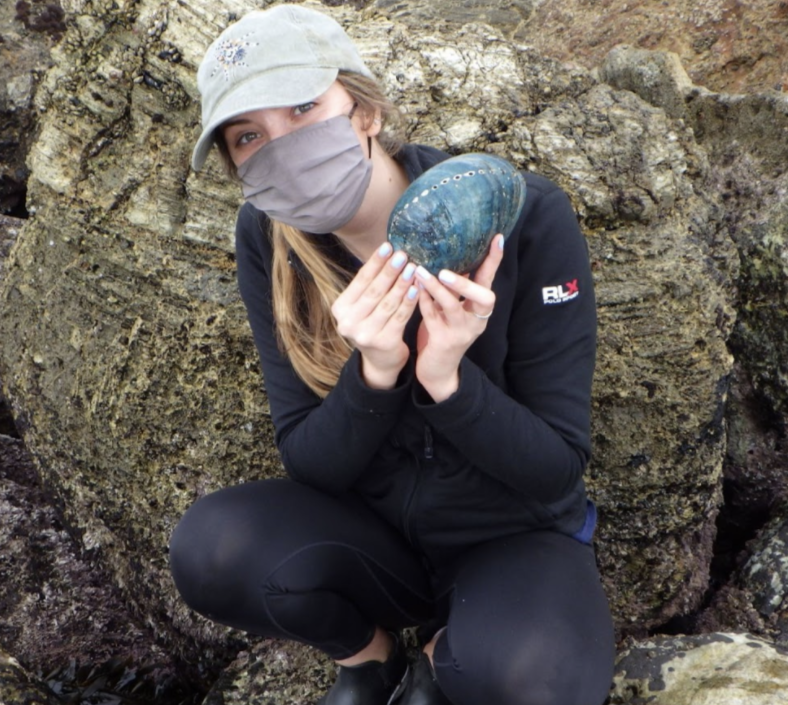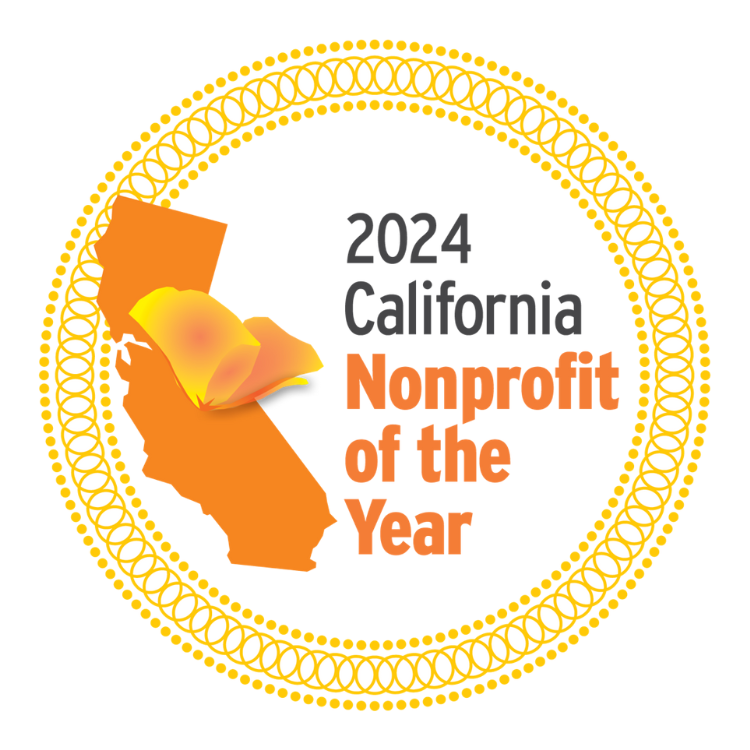Cover Photo & Blog by Education Director Michaela Coats
Decades ago, the coastline of Orange County was popular with a group of charismatic marine snails: abalone (Haliotis spp.). For centuries, abalone were a critical part of the economies and cultures of coastal communities. They provided lucrative opportunities for commercial and recreational fisheries, and were highly valued by indigenous communities. However, over the past century, abalone populations have been in peril which has led researchers and marine resource managers to jump into action and fight for their recovery.
Black abalone (Haliotis chacherodii), one of the seven abalone species found in California, have experienced drastic declines throughout the majority of their range (the geographical area in which they can be found) since the 1980s. The decline of black abalone can be attributed to both fishery overexploitation and the spread of a disease called withering syndrome. Withering syndrome is a pathogenic disease that attacks the abalone’s digestive organs, leading to starvation and/or predation (Crosson et al. 2014). The black abalone fishery peaked in 1973 at a massive harvest of 868 tons (Rogers-Bennett et al. 2002). Because of these two factors, their populations plummeted, with over half of their range experiencing declines of 80-90%, eventually closing the fishery in 1993 and catalyzing research and management efforts towards their recovery.
Black abalone were federally listed on the Endangered Species Act (1973) in 2009 and critical habitat was designated in 2011. The Final Black Abalone Recovery Plan, which was published in November of 2020, details eight major recovery actions that focus on supporting natural recovery, protecting and restoring habitat, and enhancing local populations through methods such as captive breeding and outplanting.
As broadcast spawners, abalone spew their gametes into the environment in hopes that egg and sperm meet which means there needs to be a minimum density of individuals to have a fair chance of successful fertilization (Babcock 1999). Because of the severe population decline, their reproductive and recruitment capacity are limited within subpopulations.
To mediate this roadblock to their recovery, researchers aim to have black abalone captively bred in a lab and then out planted. The Black Abalone Recovery Team is the collaborative group of state and federal agencies and universities working towards the species’ recovery. Before they are moved from their cozy lab out into the real world, they have to know where to move them.
To fill this need, my capstone team (Carmen Gardner, Khai Dang, and myself), through UC Irvine’s Masters in Conservation and Restoration Science program and in partnership with the National Oceanic and Atmospheric Administration (NOAA) Fisheries, conducted habitat assessments along the Orange County coastline to uncover which rocky intertidal sites would best suit the recovery needs of black abalone.

To determine each site’s suitability for black abalone, we quantitatively evaluated a range of habitat factors deemed essential at 18 sites within three Orange County Marine Protected Areas (MPA): Crystal Cove State Marine Conservation Area (SMCA), Laguna Beach State Marine Reserve (SMR), and Dana Point SMCA. These critical habitat factors include complex geomorphology, food availability, and biotic interactions in settlement habitat.
However, black abalone are an intertidal species which means they live amongst the shoreline that is exposed at low tide. This makes them more accessible and thus more susceptible to illegal poaching. We therefore wanted to evaluate the potential severity of human impacts at these sites, particularly because of the high population density of coastal Orange County.
Coastkeeper’s MPA Watch program, whose purpose is to document human usage of our MPAs so the data can be used to advocate for resource allocation to best ensure MPA compliance, has years of data on human behavior within our study sites. We analyzed the MPA Watch data by assigning each recorded activity a value of +1, 0, or -1 based on its potential impact to abalone and their habitat. Each site then received a human impacts score which was the summation of the assigned values. We additionally calculated the rates of enforcement presence and MPA violations at each individual site and within MPA type.
Our analysis found that:
- There is a weak negative relationship between enforcement presence and MPA violations, so more enforcement did not equate to less violations
- There are equal rates of enforcement presence between SMCAs and SMRs, but rates of violations are much higher in SMCAs
- Crystal Cove SMCA had the highest rates of MPA violations while the Laguna Beach SMR had the lowest
When trying to maximize MPA compliance, stakeholders must find the balance between enforcement and education. Many popular tide pools have docents or interpreters which act as a combination of the two avenues. Some of the major priorities for the Orange County Marine Protected Area Council (OCMPAC) include engaging kids/high school students in ocean stewardship through targeted education programs, increasing prevalence of signage, and installing surveillance technology at poaching hotspots.
When drawing our final conclusions, we took into account whether human impacts could be mitigated through these various actions. Although human behavior was only one of ten factors taken into consideration for our final recommendations, there must be proactive management of any and all potential threats. By doing so, there is hope that black abalone can return to Orange County’s intertidal communities.
Thank you to all of the MPA Watch volunteers who contributed data, and thank you to Ray Hiemstra for providing my team with this data. Together, we were able to inform NOAA on the future recovery of the endangered black abalone in Orange County.
To learn more about the research and recommendations, you can watch our final presentation here.
Resources:
For more information and to sign up to become an MPA Watch surveyor, visit: https://www.coastkeeper.org/research/mpa-watch-program/
For more resources on MPAs, including rules and regulations, in Orange County, visit: https://www.mpacollaborative.org/oc/
To watch my team present our research for the Cabrillo National Monument, visit: https://www.youtube.com/watch?v=IAJxIvOsS38&t=600s
Babcock, R. and Keesing, J. (1999). Fertilization Biology of the Abalone Haliotis laevigata: Laboratory and Field Studies. Canadian Journal of Fisheries and Aquatic Sciences, 56, 1668-1678.
Crosson, L.M., Wight, N., VanBlaricom, G.R., Kiryu, I., Moore, J.D., & Friedman, C.S. (2014). Abalone withering syndrome: Distribution, impacts, current diagnostic methods and new findings. Diseases of Aquatic Organisms, 108(3), 261-270.
Rogers-Bennett, L., Haaker, P.L., Huff, T. O., Dayton, P. K. (2002). Estimating baseline abundances of abalone in California for restoration. California Cooperative Oceanic Fisheries Investigations Report, 43, 97-111.






